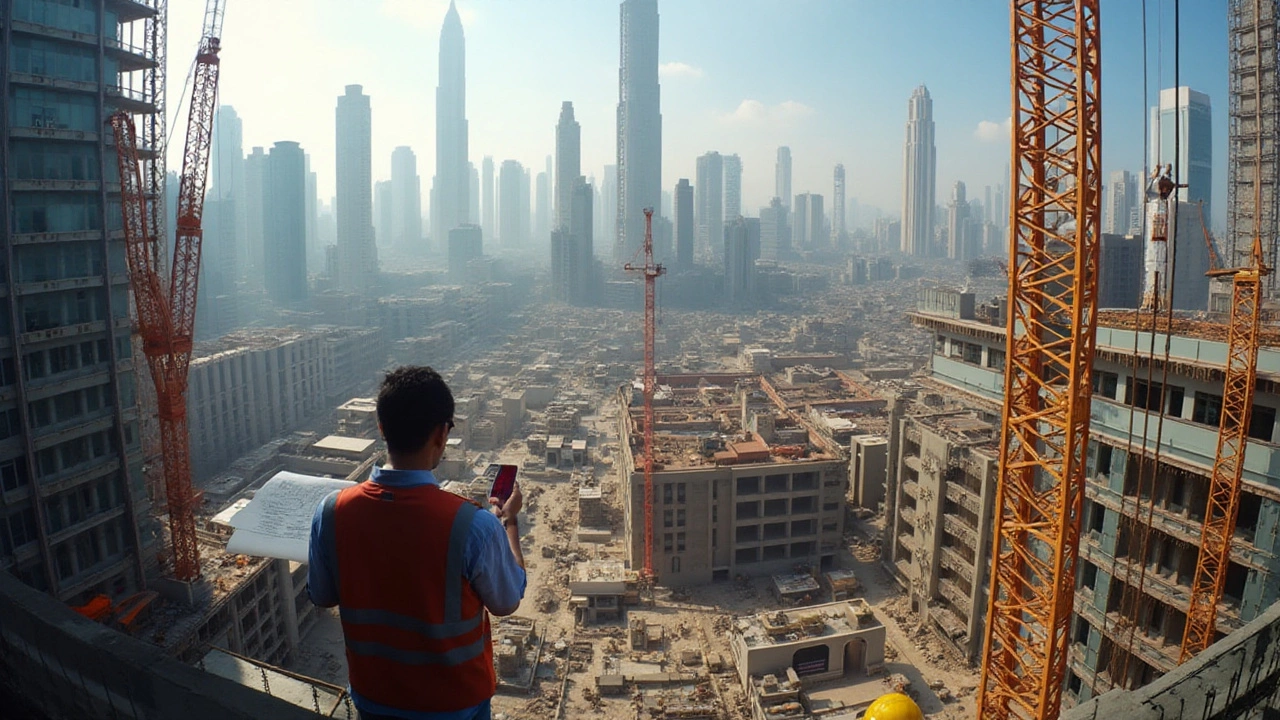The Real Costs of Building a New Home: Unveiling Factors Behind Rising Expenses

The dream of crafting a personalized refuge seems increasingly elusive as the costs of building a new house continue to climb. Yet, behind this surge lie understandable, albeit complex, factors. From the price tags attached to lumber and concrete to the availability of skilled workers, every piece of the puzzle affects your budget in a big way.
Moreover, navigating the labyrinth of permits and regulations throws in its own set of challenges, stretching timelines and budgets. But it's not all bleak; there are strategies that can be employed to manage and monitor these expenses effectively.
By peeling back the layers and examining what drives these costs, prospective homeowners can not only stay informed but also explore avenues that might ease the financial strain. So, before you embark on what might be the biggest investment of your life, ensure you're equipped with the knowledge to do so wisely.
- Material Costs and Their Impact
- Labor Challenges in Construction
- Regulatory and Permitting Expenses
- Strategies for Cost-Effective Building
Material Costs and Their Impact
In the ever-evolving world of home construction, a key propellant of expense is the price of building materials. The fluctuations in these costs can be stunning, driven by a cocktail of factors ranging from global supply chain disruptions to simple demand and supply laws. For instance, the recent global events highlighted how reliant we've become on international trade for materials like lumber, steel, and concrete. Lumber, once a fairly stable aspect of budgeting, skyrocketed during the pandemic of 2020 due to sawmill closures and unexpected surges in home improvement projects. Such scenarios can add thousands of dollars to initial project budgets, upending financial plans before a single brick is laid.
Beyond these external factors, local elements also play a crucial role in how material costs impact the construction of a new home. Regional availability of resources can lead to stark differences in pricing. For example, areas rich in timber offer relatively cheaper wood, easing the cost burden for those building wooden structures, while desert regions might incur fewer expenses for sand and gravel. Potential homeowners are often surprised to learn that the same house can have wildly differing costs in two different areas, all due to material accessibility.
Additionally, there's the innovation ebb and flow — with new construction technologies and sustainable building practices leading to both savings and additional costs. Materials like recycled steel or green concrete may promise long-term savings and environmental benefits, but their initial costs can be prohibitive without suitable subsidies or incentives. Some experts advocate for reconsidering traditional cost analysis. As famed architect Frank Lloyd Wright once noted,
"Instead of using steel, why not find a simpler material that can do the job smarter?"It's this kind of thinking that could potentially shift the financial paradigms of construction in the future.
The volatility of construction costs is sometimes accentuated by unexpected economic shifts. For instance, tariffs can abruptly alter the price landscape, as seen with metals like aluminum and steel when particular fiscal policies come into play. In an interesting twist, while prices can surge due to shortages, they can also plummet if a sudden market oversupply occurs, though such deductions are less common in existing housing demand scenarios. It's a delicate balance that necessitates careful market analysis and flexible planning.
To provide a snapshot of these varying costs, here's an illustrative table:
| Material | Average Cost per Unit (2023) | Projected Increase (2024) |
|---|---|---|
| Lumber | $800 per 1,000 board feet | 5% |
| Reinforced Steel | $750 per ton | 3% |
| Concrete | $110 per cubic yard | 2% |
Recognizing the trends in material costs is not merely about understanding numbers; it’s about foreseeing the construction landscape and embracing strategies to mitigate these expenses. In this respect, developing a healthy relationship with suppliers can be a game-changer, potentially securing better prices or timely information about upcoming changes. Some builders recommend locking in material prices early in the planning stages, which can be secured through contracts with suppliers, thus cushioning against future price hikes.

Labor Challenges in Construction
One of the most critical elements inflating the cost of building a new home is the landscape of labor in the construction industry. Over recent years, a persistent shortage of skilled workers has reverberated through the sector, causing delays and hiking up expenses. The construction industry faces a unique crisis as many aging workers retire, leaving a void that the younger generation has not been filling at a sustainable rate. This shortage drives competition for the available workforce, pushing wages upward, which directly impacts the pricing of new builds.
With the rise in demand for new homes, particularly in rapidly growing urban areas, contractors often find themselves struggling to keep up with schedules when their teams are understaffed. Long hours and pressing deadlines can lead to burnout and turnover, further complicating labor availability. Additionally, specialized roles such as electricians and plumbers command higher fees due to the scarcity of qualified professionals. Construction costs for new homes inevitably increase when these professionals are in short supply.
Technology offers a double-edged solution here; while it can streamline certain processes and reduce manual labor, it also requires workers to be trained in new systems, which can be both time-consuming and costly. It’s a balancing act trying to implement cutting-edge solutions without overspending or contributing to project delays due to insufficiently trained staff. The industry is taking steps towards educational programs to replenish its workforce, but these initiatives will take time to bear fruit.
According to the Associated General Contractors of America (AGC), "Eighty-one percent of construction firms are having a hard time filling positions, which is a significant challenge for timely project completion."
Cultural shifts also play their part. Younger generations often gravitate towards technology and white-collar industries, perceiving them as offering more glamorous career paths than traditional trades. Rebranding the image of construction work to highlight its lucrative aspects and its potential for innovation could attract new interest but changing perceptions can be a slow process. New home expenses ultimately reflect these societal trends.
To mitigate these labor challenges, many firms are looking towards inventive solutions. Partnerships with vocational schools, more robust apprenticeship programs, and even international recruitment are part of a broader strategy some companies are employing to bolster their ranks. By understanding these dynamics, potential homeowners can better anticipate delays or cost spikes during their building projects, preparing them for a smoother construction experience.

Regulatory and Permitting Expenses
When building a new home, regulatory and permitting expenses form an essential component of the financial puzzle. These expenses often come as an unwelcome surprise to many first-time builders. The process typically begins with acquiring a building permit from the local municipal authority, a mandatory step that ensures your new home complies with regional safety and zoning laws. While this step might seem straightforward, the intricacies involved can often lead to delays and additional costs. Navigating through the local ordinances, building codes, and environmental guidelines necessitates meticulous attention to detail, often making the regulatory landscape feel like a veritable minefield for homeowners.
Obtaining these permits is not merely about paperwork; it encompasses submission to a rigorous series of inspections by city officials, each stage ensuring compliance with safety standards defined by law. The initial permit application fee is only the tip of the iceberg. Depending on the complexity and the architectural design of the intended construction, fees can accumulate as inspections for electrical, plumbing, and fire safety are conducted. This is why consulting with seasoned professionals, such as architects or urban planners familiar with local regulations, can provide invaluable guidance.
Interestingly, the time taken to secure permits has increased in many places over the past five years, attributed mainly to enhanced safety reviews and increased demand for housing in urban areas. According to a report by the National Association of Home Builders, the average duration to obtain a building permit in metropolitan areas has shifted from several weeks to months in some cases.
"The time and cost associated with securing building permits have steadily increased, contributing to the overall expense of new home construction," notes an official from the National Association of Home Builders.This statistic illustrates just how vital it is for prospective builders to factor time as an indirect cost in their project planning. Delays in obtaining permits can lead to extended timelines, affecting everything from labor costs to the scheduling of subcontractors, ultimately adding financial strain on the project budget.
Besides these direct regulatory fees, various indirect expenses can emerge. Environmental assessments, for instance, have become more frequent due to growing emphasis on eco-friendly building practices. If your construction project lands in a region home to protected ecosystems or endangered species, engaging environmental consultants becomes unavoidable, adding another layer of cost and complexity. This ecological consideration reflects the broader global movements toward sustainable development and responsible construction. These assessments ensure that construction activities do not adversely affect the natural surroundings, hence fostering ecological balance. Many builders, recognizing the importance of these analyses, incorporate them as indispensable steps in their building preparations, underscoring the balancing act required between development and environmental stewardship.
Moreover, understanding local zoning laws can make or break a building project. These laws dictate what can be built where, and non-compliance can result in severe penalties or project modifications. For developers and homeowners alike, constant communication with legal experts and regulatory bodies during the planning stage is imperative. Knowing the ins and outs of zoning restrictions can help in choosing the optimal site for your construction and in understanding any potential limitations on land use. This knowledge forms the backbone of a successful build, blending the intricate dance of adhering to legal standards with the ambition of creating a comfortable, personal space.

Strategies for Cost-Effective Building
Crafting a cost-effective strategy for building your new home involves a careful blend of planning, research, and a bit of creativity. For many prospective homeowners, the initial step is to set a realistic budget. This does not just mean calculating how much you can spend, but also how much you should spend. It's crucial to factor in all potential expenses, from land acquisition, permits to interior finishing. Predictable costs such as taxes and utility access fees must also be included. Consider consulting with a financial advisor to ensure that your forecasts align with your financial capabilities. This initial stage helps in framing the constraints within which you will operate.
Once you have a budget in place, focus on the design aspect of your future home. Opting for a simpler, more efficient design can significantly impact the construction costs. Streamlined house designs typically utilize space better and require fewer materials, naturally cutting down costs. Work with architects who specialize in eco-friendly designs as they aim to minimize waste and maximize the utility of each material used in the process. This might also involve considering modular or prefabricated homes known for their affordability without compromising on quality or aesthetics.
Labor expenses can be a daunting chunk of your budget, but strategic hiring and scheduling can help. Hiring reputable contractors with a proven track record for punctuality and budget integrity is key. Request bids from multiple contractors and scrutinize these to choose the best value—not necessarily the cheapest. According to a 2023 survey by the National Association of Home Builders, negotiation can potentially save you up to 5% on labor costs. Efficient scheduling is imperative to avoid potential downtime where costs can swell due to unproductive labor hours.
"Building a home is all about careful orchestration," notes Emily Barker, editor at Home Builder Daily. "With the right timing and coordination, significant savings can be accomplished."
Homeowners often overlook the savings potential in smart purchasing. Materials represent a large portion of building expenses, and being savvy with purchases is crucial. Consider bulk buying for materials that allow, as suppliers might offer discounts. Reclaimed materials, such as doors, windows, and even hardwood flooring, can be cost-effective and add a unique charm to your new space. Demonstrating flexibility with materials can lead to significant savings. Online marketplaces can prove beneficial for finding high-quality materials at a fraction of the cost.
DIY Projects and Involvement
Incorporating a DIY approach can significantly help cut costs in non-essential areas. Engage in manageable tasks like painting, landscaping, or even installing fixtures. These activities not only reduce the amount paid out in labor but also bring a sense of personal accomplishment. However, a word of caution: do not overestimate your capabilities. It's vital to leave the more complex tasks such as electrical and plumbing work to seasoned professionals, mitigating the risk of costly mistakes.
To wrap it all together, maintaining flexibility and open communication throughout the project is critical. Regularly review expenditures and progress to ensure the budget remains intact. Unexpected expenses are inevitable, but a well-structured strategy built on informed choices can significantly ease the financial burden associated with building a house.